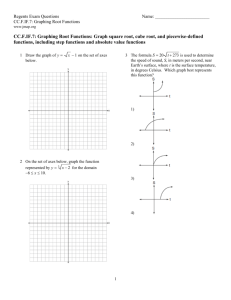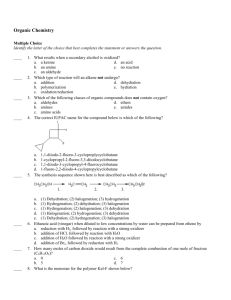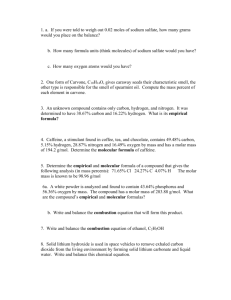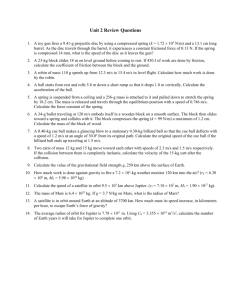File
advertisement
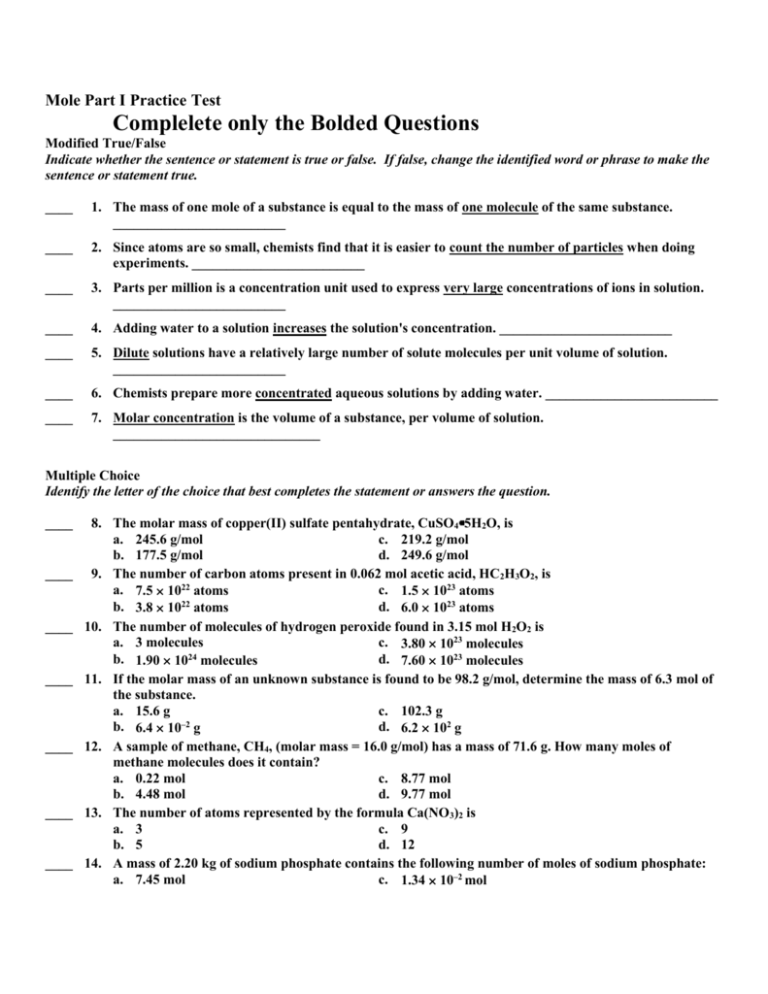
Mole Part I Practice Test Complelete only the Bolded Questions Modified True/False Indicate whether the sentence or statement is true or false. If false, change the identified word or phrase to make the sentence or statement true. ____ 1. The mass of one mole of a substance is equal to the mass of one molecule of the same substance. _________________________ ____ 2. Since atoms are so small, chemists find that it is easier to count the number of particles when doing experiments. _________________________ ____ 3. Parts per million is a concentration unit used to express very large concentrations of ions in solution. _________________________ ____ 4. Adding water to a solution increases the solution's concentration. _________________________ ____ 5. Dilute solutions have a relatively large number of solute molecules per unit volume of solution. _________________________ ____ 6. Chemists prepare more concentrated aqueous solutions by adding water. _________________________ ____ 7. Molar concentration is the volume of a substance, per volume of solution. ______________________________ Multiple Choice Identify the letter of the choice that best completes the statement or answers the question. ____ ____ ____ ____ ____ ____ ____ 8. The molar mass of copper(II) sulfate pentahydrate, CuSO4 5H2O, is a. 245.6 g/mol c. 219.2 g/mol b. 177.5 g/mol d. 249.6 g/mol 9. The number of carbon atoms present in 0.062 mol acetic acid, HC2H3O2, is a. 7.5 1022 atoms c. 1.5 1023 atoms b. 3.8 1022 atoms d. 6.0 1023 atoms 10. The number of molecules of hydrogen peroxide found in 3.15 mol H2O2 is a. 3 molecules c. 3.80 1023 molecules 24 b. 1.90 10 molecules d. 7.60 1023 molecules 11. If the molar mass of an unknown substance is found to be 98.2 g/mol, determine the mass of 6.3 mol of the substance. a. 15.6 g c. 102.3 g b. 6.4 10–2 g d. 6.2 102 g 12. A sample of methane, CH4, (molar mass = 16.0 g/mol) has a mass of 71.6 g. How many moles of methane molecules does it contain? a. 0.22 mol c. 8.77 mol b. 4.48 mol d. 9.77 mol 13. The number of atoms represented by the formula Ca(NO3)2 is a. 3 c. 9 b. 5 d. 12 14. A mass of 2.20 kg of sodium phosphate contains the following number of moles of sodium phosphate: a. 7.45 mol c. 1.34 10–2 mol ____ 15. ____ 16. ____ 17. ____ 18. ____ 19. ____ 20. ____ 21. ____ 22. ____ 23. ____ 24. ____ 25. ____ 26. ____ 27. ____ 28. b. 74.5 mol d. 13.4 mol The mass found in 0.10 mol KHC4H4O6 is a. 4.6 g c. 23.7 g b. 19 g d. 37.6 g A possible molecular formula for the compound CH2O is a. C2H4O2 c. C4H8O4 b. C3H6O3 d. all of the above The percentage of nitrogen, by mass, in nitric acid, HNO3, is a. 1.6% c. 15.6% b. 11.1% d. 22.2% The percentage of oxygen, by mass, in calcium hydrogen carbonate, Ca(HCO3)2, is a. 24.7% c. 14.8% b. 59.2% d. 1.2% The percentage composition by mass of each element in sodium sulfate, Na2SO4, is a. 32.4% Na, 22.6% S, 45.0% O c. 43.7% Na, 20.7% S, 35.6% O b. 22.6% Na, 32.4% S, 45.0% O d. 20.7% Na, 43.7% S, 35.6% O Which of the following could be an empirical formula? a. C24H44O22 c. CH3OH b. N2O4 d. C4H8 Hydrogen peroxide is known to contain 5.9% hydrogen and 94.1% oxygen, by mass. If its molar mass is 34.0 g/mol, its molecular formula is a. HO c. HO2 b. H2O2 d. HO3 A compound with a molar mass of 78.0 g/mol is found to contain 92.29% carbon and 7.71% hydrogen, by mass. The molecular formula of the compound is a. CH c. C3H3 b. C2H3 d. C6H6 A compound has a molar mass of 170.0 g/mol and an empirical formula of SiF3. The compound's molecular formula is a. SiF3 c. Si2F6 b. Si5F15 d. Si4F12 A compound was found to contain 10.06% carbon, 89.10% chlorine, and 0.84% hydrogen, by mass. If the molar mass of the compound was found to be 119.6 g/mol, its molecular formula will be a. CHCl3 c. CH3Cl3 b. CH3Cl d. C3H3Cl3 A substance is 86% carbon and 14% hydrogen. Which of the following statements is definitely true? a. The empirical formula is C3H6. c. The empirical formula is CH2. b. The molecular formula is C3H6. d. The molecular formula is CH2. A solution that has a relatively large quantity of solute dissolved in the solvent is a. homogeneous c. concentrated b. dilute d. mixed What is the molar concentration of 0.20 mol potassium hydroxide in 0.75 L of solution? a. 0.37 mol/L c. 2.66 mol/L b. 3.75 mol/L d. 0.27 mol/L 2.0 g of NaOH is added to 100 mL of water. What is the concentration of the solution? a. 0.02 mol/L c. 0.5 mol/L b. 5.0 mol/L d. 0.05 mol/L ____ 29. What volume of water is needed to dilute 25 mL of a 0.5-mol/L solution of NaCl to 0.35 mol/L? a. 35 mL c. 0.35 L b. 10 mL d. 25 mL Completion Complete each sentence or statement. 30. A(n) ____________________ formula shows the ratio between the number of atoms in a substance in its simplest terms. 31. The actual number of atoms that make up a molecule is shown by a(n) ____________________ formula. 32. CH2O is the ____________________ formula of C6H12O6. 33. The empirical formula for acetic acid, CH3COOH, is ____________________. 34. The symbol used to represent Avogadro's constant is ____________________. 35. The mass of an element in a compound divided by the total mass of that compound, then multiplied by 100 is known as the element’s ______________________________. 36. A(n) ____________________ solution is one that contains a small amount of solute dissolved in the solvent. 37. Percent by mass concentration can be calculated by dividing the mass of the _________________________ by the mass of the solution and multiplying by 100. Matching Match each term with its correct definition below. a. solution f. b. solute g. c. solvent h. d. % V/V i. e. concentrated j. ____ ____ ____ ____ ____ ____ ____ ____ ____ 38. 39. 40. 41. 42. 43. 44. 45. 46. % W/V concentration molar concentration dilute ppm having a relatively large quantity of solute per unit volume of solution substance that is dissolved in a solvent amount of solute, in moles, dissolved in one litre of solution liquid medium in which a solute is dissolved quantity of a given solute in a given volume of solution unit used for very low concentrations homogeneous mixture of one solute and one solvent concentration expressed as solute volume in solvent volume concentration expressed as mass of solute in volume of solution Short Answer 47. Determine the number of molecules found in 5.00 mol water. 48. Calculate the number of moles of lead present in 8.6 1017 atoms of Pb. 49. Determine the molar mass of mercury(II) sulfide. 50. Ammonium carbonate is commonly found in smelling salts. Determine the molar mass of (NH 4)2CO3. 51. Convert 0.227 mol potassium sulfate, K2SO4, into mass (in grams). 52. Calculate the mass (in grams) found in 0.805 mol sulfur. 53. Convert a mass of 89.7 g of lithium hydroxide, LiOH, into an amount in moles. 54. Calculate the number of moles found in 168.0 g of iron(II) oxide, FeO. 55. Briefly state the difference between empirical and molecular formulas and provide an example of each. 56. A solution is made using 15 mL of sulfuric acid in 1000 mL of water. What is the percentage V/V concentration of the new solution? 57. What is the percentage weight/volume concentration of a 250-mL solution made with 15 g of sodium hydroxide? 58. 0.375 mol NaCl is dissolved in 100 mL of water. What is the concentration of the new solution? 59. What amount of sodium hydroxide, NaOH, is present in 36 mL of a 0.010-mol/L solution? 60. What volume of a 0.370-mol/L solution of KI is needed to obtain 0.032 mol KI? 61. 2.6 mg of lead(II) nitrate, Pb(NO3)2, is dissolved in 1.2 L of water. What is the concentration of the Pb(NO3)2 in parts per million? Problem 62. Sulfur dioxide can be used in preserving fruits and vegetables. Determine the percentage composition, by mass, of each element in SO2. 63. Sodium thiosulfate, Na2S2O3, can be used as a fixer in the field of photography. Calculate the percentage composition, by mass, of each element in sodium thiosulfate. 64. A compound was found to contain 10.06% C, 89.10% Cl, and 0.84% H, by mass. If the molar mass of the compound is 119.6 g/mol, calculate its molecular formula. 65. A compound was found to contain 33.0% Si and 67.0% F, by mass. If the molar mass of the compound is 170.0 g/mol, calculate its molecular formula. 66. What volume of a 17.4-mol/L acetic acid stock solution is required to make 2.0 L of a 1.5-mol/L acetic acid solution? 67. The concentration of hydrochloric acid is initially 6.0 mol/L. What would the concentration of a new solution be if 200 mL of the original HCl solution were diluted to 1.0 L with water? Mole Unit Test I Practice Answer Section MODIFIED TRUE/FALSE 1. ANS: F, 6.02 1023 molecules REF: C 2. ANS: F measure moles use moles use mass OBJ: 2.1 LOC: CC1.01 REF: I OBJ: 2.2 3. ANS: F, very small LOC: CC1.01 REF: C 4. ANS: F, decreases OBJ: 2.5 LOC: CC2.01 REF: I OBJ: 2.5 5. ANS: F, Concentrated LOC: CC2.08 REF: I 6. ANS: F, dilute OBJ: 2.5 LOC: CC2.08 REF: I OBJ: 2.5 7. ANS: F Percentage concentration Volume/volume LOC: CC2.08 REF: C OBJ: 2.5 LOC: CC2.01 REF: REF: REF: REF: REF: REF: REF: REF: REF: REF: REF: REF: REF: OBJ: OBJ: OBJ: OBJ: OBJ: OBJ: OBJ: OBJ: OBJ: OBJ: OBJ: OBJ: OBJ: MULTIPLE CHOICE 8. 9. 10. 11. 12. 13. 14. 15. 16. 17. 18. 19. 20. ANS: ANS: ANS: ANS: ANS: ANS: ANS: ANS: ANS: ANS: ANS: ANS: ANS: D A B D B C D B D D B A C I I I I I I I I K/U I I I K/U 2.1 2.2 2.2 2.2 2.2 2.1 2.2 2.2 2.3 2.3 2.3 2.3 2.3 LOC: LOC: LOC: LOC: LOC: LOC: LOC: LOC: LOC: LOC: LOC: LOC: LOC: CC2.03 CC2.05 CC2.05 CC2.05 CC2.05 CC2.05 CC2.05 CC2.03 CC2.04 CC2.04 CC2.04 CC2.04 CC2.04 21. 22. 23. 24. 25. 26. 27. 28. 29. ANS: ANS: ANS: ANS: ANS: ANS: ANS: ANS: ANS: B D C A C C D C B REF: REF: REF: REF: REF: REF: REF: REF: REF: I I I I I I I I I OBJ: OBJ: OBJ: OBJ: OBJ: OBJ: OBJ: OBJ: OBJ: 2.3 2.3 2.3 2.3 2.3 2.5 2.5 2.5 2.5 LOC: LOC: LOC: LOC: LOC: LOC: LOC: LOC: LOC: CC2.04 CC2.04 CC2.04 CC2.04 CC2.04 CC2.02 CC2.05 CC2.05 CC2.05 LOC: LOC: LOC: LOC: LOC: LOC: LOC: LOC: CC2.08 CC2.08 CC2.08 CC2.08 CC2.08 CC2.08 CC2.08 CC2.08 COMPLETION 30. ANS: empirical REF: K/U 31. ANS: molecular OBJ: 2.3 LOC: CC2.04 REF: K/U 32. ANS: empirical OBJ: 2.3 LOC: CC2.04 REF: K/U 33. ANS: CH2O OBJ: 2.3 LOC: CC2.04 REF: K/U 34. ANS: NA OBJ: 2.3 LOC: CC2.04 REF: C OBJ: 2.1 35. ANS: percentage composition LOC: CC2.01 REF: K/U 36. ANS: dilute OBJ: 2.3 LOC: CC2.04 REF: C 37. ANS: solute OBJ: 2.5 LOC: CC2.05 REF: C OBJ: 2.5 LOC: CC2.05 REF: REF: REF: REF: REF: REF: REF: REF: OBJ: OBJ: OBJ: OBJ: OBJ: OBJ: OBJ: OBJ: MATCHING 38. 39. 40. 41. 42. 43. 44. 45. ANS: ANS: ANS: ANS: ANS: ANS: ANS: ANS: E B H C G J A D I I I I I I I I 2.5 2.5 2.5 2.5 2.5 2.5 2.5 2.5 46. ANS: F REF: I OBJ: 2.5 SHORT ANSWER 47. ANS: There are 3.01 1024 water molecules in 5.00 mol water. REF: I 48. ANS: OBJ: 2.2 LOC: CC2.05 There is 1.4 106 mol lead present. REF: I 49. ANS: OBJ: 2.2 LOC: CC2.05 The molar mass of mercury(II) sulfide is 232.7 g/mol. REF: I 50. ANS: OBJ: 2.2 LOC: CC2.03 The molar mass of ammonium carbonate is 96.11 g/mol. REF: I 51. ANS: OBJ: 2.2 LOC: CC2.03 The mass of 0.227 mol potassium sulfate is 39.6 g. REF: I 52. ANS: OBJ: 2.2 LOC: CC2.05 LOC: CC2.08 The mass of 0.805 mol sulfur is 25.8 g. REF: I 53. ANS: OBJ: 2.2 LOC: CC2.05 A mass of 89.7 g of lithium hydroxide is equivalent to 3.74 mol. REF: I 54. ANS: OBJ: 2.2 LOC: CC2.05 A mass of 168.0 g of iron(II) oxide is equivalent to 2.338 mol. REF: I OBJ: 2.2 LOC: CC2.05 55. ANS: - a molecular formula shows the actual number of atoms of each element in a molecule of a compound (e.g., C6H12O6) - an empirical formula is the simplest formula and shows only the relative number of moles of each type of atom in a compound (e.g., CH2O) REF: K/U 56. ANS: OBJ: 2.3 LOC: CC2.04 REF: I 57. ANS: OBJ: 2.5 LOC: CC2.05 REF: I 58. ANS: OBJ: 2.5 LOC: CC2.05 REF: I 59. ANS: OBJ: 2.5 LOC: CC2.05 The solution contains 3.6 104 mol NaOH. REF: I 60. ANS: OBJ: 2.5 LOC: CC2.05 A volume of 0.086 L is needed. REF: I 61. ANS: OBJ: 2.5 LOC: CC2.05 The concentration of lead(II) nitrate is 2.17 ppm. REF: I OBJ: 2.5 LOC: CC2.05 PROBLEM 62. ANS: The percentage composition of sulfur dioxide is 50.08% sulfur and 49.92% oxygen. REF: I 63. ANS: OBJ: 2.3 LOC: CC2.04 The percentage composition, by mass, of sodium thiosulfate is 29.08% sodium, 40.58% sulfur, and 30.34% oxygen. REF: I 64. ANS: OBJ: 2.3 LOC: CC2.04 The molar ratio for C:Cl:H is 0.84:2.51:0.83. Dividing by 0.83 to obtain the lowest ratio, we find the molar ratio (when rounded) to be 1:3:1. The empirical formula of the compound is CCl3H. The molecular formula of the compound is CCl3H. REF: I 65. ANS: OBJ: 2.3 LOC: CC2.04 The molar ratio for Si:F is 1.17:3.53. Dividing by 1.17, we obtain the molar ratio (when rounded) of 1:3. The empirical formula of the compound is SiF3. The molecular formula of the compound is Si2F6. REF: I 66. ANS: OBJ: 2.3 LOC: CC2.04 The volume of stock acetic acid solution needed is 1.7 102 mL. REF: I 67. ANS: OBJ: 2.5 LOC: CC2.08 The concentration of the diluted hydrochloric acid solution is 1.2 mol/L. REF: I OBJ: 2.5 LOC: CC2.08 ESSAY 68. ANS: Answers should include the following points: - one mole represents 6.02 1023 particles of any substance - the mole is the SI standard unit of chemical quantity - chemists are not concerned with the number of atoms or particles because it is impossible to count the quantities; instead, they are concerned with the masses of the substances - the atomic mass of a single particle is very small, therefore, it is difficult for chemists to measure the mass - 6.02 1023 particles of a substance have a mass in grams that is equivalent to the atomic mass of the substance in u - chemists can then measure the mass of the substance in grams REF: K/U OBJ: 2.1 LOC: CC1.01





